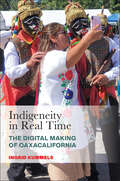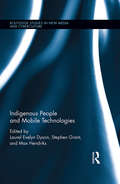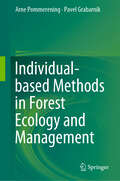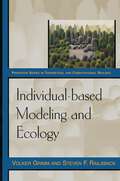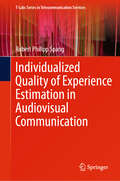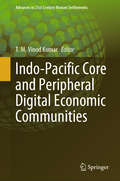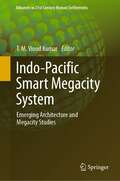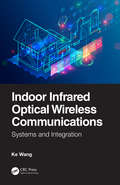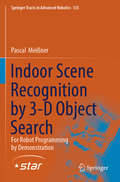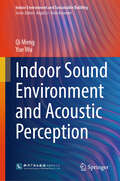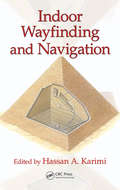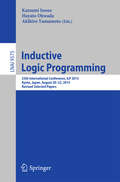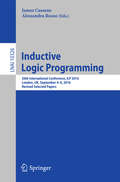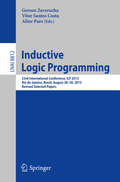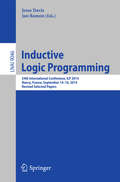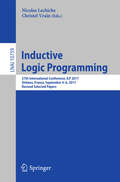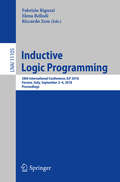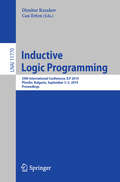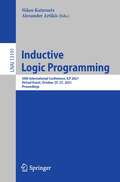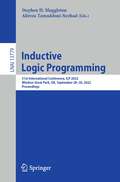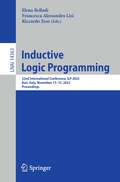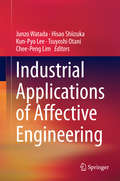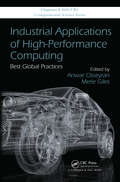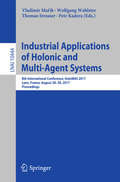- Table View
- List View
Indigeneity in Real Time: The Digital Making of Oaxacalifornia (Latinidad: Transnational Cultures in the United States)
by Ingrid KummelsLong before the COVID-19 crisis, Mexican Indigenous peoples were faced with organizing their lives from afar, between villages in the Oaxacan Sierra Norte and the urban districts of Los Angeles, as a result of unauthorized migration and the restrictive border between Mexico and the United States. By launching cutting-edge Internet radio stations and multimedia platforms and engaging as community influencers, Zapotec and Ayuujk peoples paved their own paths to a transnational lifeway during the Trump era. This meant adapting digital technology to their needs, setting up their own infrastructure, and designing new digital formats for re-organizing community life in all its facets—including illness, death and mourning, collective celebrations, sport tournaments, and political meetings—across vast distances. Author Ingrid Kummels shows how mediamakers and users in the Sierra Norte villages and in Los Angeles created a transborder media space and aligned time regimes. By networking from multiple places, they put into practice a communal way of life called Comunalidad and an indigenized American Dream—in real time.
Indigenous People and Mobile Technologies (Routledge Studies in New Media and Cyberculture)
by Laurel Evelyn Dyson Stephen Grant Max HendriksIn the rich tradition of mobile communication studies and new media, this volume examines how mobile technologies are being embraced by Indigenous people all over the world. As mobile phones have revolutionised society both in developed and developing countries, so Indigenous people are using mobile devices to bring their communities into the twenty-first century. The explosion of mobile devices and applications in Indigenous communities addresses issues of isolation and building an environment for the learning and sharing of knowledge, providing support for cultural and language revitalisation, and offering the means for social and economic renewal. This book explores how mobile technologies are overcoming disadvantage and the tyrannies of distance, allowing benefits to flow directly to Indigenous people and bringing wide-ranging changes to their lives. It begins with general issues and theoretical perspectives followed by empirical case studies that include the establishment of Indigenous mobile networks and practices, mobile technologies for social change and, finally, the ways in which mobile technology is being used to sustain Indigenous culture and language.
Individual-based Methods in Forest Ecology and Management
by Arne Pommerening Pavel GrabarnikModel-driven individual-based forest ecology and individual-based methods in forest management are of increasing importance in many parts of the world. For the first time this book integrates three main fields of forest ecology and management, i.e. tree/plant interactions, biometry of plant growth and human behaviour in forests. Individual-based forest ecology and management is an interdisciplinary research field with a focus on how the individual behaviour of plants contributes to the formation of spatial patterns that evolve through time. Key to this research is a strict bottom-up approach where the shaping and characteristics of plant communities are mostly the result of interactions between plants and between plants and humans. This book unites important methods of individual-based forest ecology and management from point process statistics, individual-based modelling, plant growth science and behavioural statistics. For ease of access, better understanding and transparency the methods are accompanied by R code and worked examples.
Individual-based Modeling and Ecology (Princeton Series in Theoretical and Computational Biology #2)
by Volker Grimm Steven F. RailsbackIndividual-based models are an exciting and widely used new tool for ecology. These computational models allow scientists to explore the mechanisms through which population and ecosystem ecology arises from how individuals interact with each other and their environment. This book provides the first in-depth treatment of individual-based modeling and its use to develop theoretical understanding of how ecological systems work, an approach the authors call "individual-based ecology.? Grimm and Railsback start with a general primer on modeling: how to design models that are as simple as possible while still allowing specific problems to be solved, and how to move efficiently through a cycle of pattern-oriented model design, implementation, and analysis. Next, they address the problems of theory and conceptual framework for individual-based ecology: What is "theory"? That is, how do we develop reusable models of how system dynamics arise from characteristics of individuals? What conceptual framework do we use when the classical differential equation framework no longer applies? An extensive review illustrates the ecological problems that have been addressed with individual-based models. The authors then identify how the mechanics of building and using individual-based models differ from those of traditional science, and provide guidance on formulating, programming, and analyzing models. This book will be helpful to ecologists interested in modeling, and to other scientists interested in agent-based modeling.
Individualized Quality of Experience Estimation in Audiovisual Communication (T-Labs Series in Telecommunication Services)
by Robert Philipp SpangThe book presents an in-depth exploration of the Individuality Assisted Estimation (IAE) model in the context of Quality of Experience (QoE) assessment for multimedia, specifically audiovisual communication. The book delves into how individual characteristics, including psychological traits and states, influence perceptions of multimedia quality. The book argues for the integration of individual differences into these assessments, hypothesizing that this approach can enhance the accuracy and relevance of QoE ratings. Through a series of experiments and analyses, the book rigorously evaluates the effectiveness of the IAE model, comparing it against traditional methods, and highlights its particular strengths in estimating task load. The research contributes to the field by emphasizing the importance of individuality in multimedia quality assessment and offering a practical, empirically validated approach for incorporating individual differences into QoE models.
Indo-Pacific Core and Peripheral Digital Economic Communities (Advances in 21st Century Human Settlements)
by T. M. Vinod KumarThis book demonstrates to the world by a series of replicable case studies, how the Indo-Pacific developmental initiatives of QUAD, France, Germany, the Netherlands, Canada, the European Union, Japan, Australia, and others can be implemented using the design of “Core Digital Economic Communities” within the 21 megacities that form Indo pacific megacity system and outside with independent country strategies to engage with these megacity systems where “Peripheral Digital Economic Communities” are located.
Indo-Pacific Smart Megacity System: Emerging Architecture and Megacity Studies (Advances in 21st Century Human Settlements)
by T. M. Vinod KumarThis book is an in-depth study of the Indo-Pacific region for effective interventions in the megacities system. First, based on several criteria, the region is identified as homogeneous country groupings of diversity, a multi-polar spatial system, and as program regions of QUAD and I2U2 for action programs and investment transcending many nations but mostly the ocean space of the Indo-Pacific, connecting all megacities sub-regions spatially and functionally. Then, the megacities with problems and prospects for economic integration are studied from the point of view of regional economics and international trade, and finally, the rural–urban interface with case studies of selected countries is presented. Prospects of systems of megacities and individual megacities for regional economies are designed. Existing interconnections through rail, air, and ocean of megacity systems, their capacity, performance, and potential are analyzed for emerging issues. International trade among the megacity systems/countries with emerging issues and barriers are presented. The mobility of money, goods, and services among the systems of megacities is analyzed. Rule-based diplomacy and other emerging options are discussed to sustain the above calls for a study of the Security of the Indo-Pacific region. Finally, the emerging architecture for megacity system governance is also presented.Out of 21 megacities in the Indo-Pacific, an in-depth study of a few in India and Japan in the Indo-Pacific region for effective economic interventions in the megacities system at the city level was studied. COVID-19 has affected most of the countries in the Indo-Pacific. With a contraction of GDP and a GDP growth rate negative, the number below the poverty level increased. Foreign Direct Investment is not forthcoming in any of these countries. Job creation becomes a priority in addition to public health concerns connected with COVID-19.
Indoor Infrared Optical Wireless Communications: Systems and Integration
by Ke WangThis book aims to give an overview of recent developments in indoor near-infrared optical wireless communication technologies and systems, including basic theories, operating fundamentals, system architectures, modelling, experimental demonstrations, advanced techniques, and most recently, the research efforts towards integrations. Both line-of-sight and diffusive-signals-based options will be reviewed, to provide readers a complete picture about this rapidly developing area, which targets the provision of high-speed wireless connectivity to end- users in indoor environments, such as offices, homes and shopping centres, to satisfy the growing high-speed communication requirement. Provides a systematic approach for the fundamentals of indoor optical wireless communications. Provides an overview of recent developments in indoor infrared optical wireless communications, including theoretical fundamentals. Examines system architectures, modelling, experimental demonstrations, and the research efforts towards integrations. Dr. Ke Wang is an Australian Research Council (ARC) DECRA Fellow and a senior lecturer in the School of Engineering, Royal Melbourne Institute of Technology (RMIT University), VIC, Australia. He worked with the University of Melbourne, Australia, and Stanford University, California, before joining RMIT University. He has published over 110 peer-reviewed papers in top journals and leading international conferences, including over 20 invited papers. He has been awarded several prestigious national and international awards as recognition of research contributions, such as the Victoria Fellowship, the AIPS Young Tall Poppy Science Award, and the Marconi Society Paul Baran Young Scholar Award. His major areas of interest include: silicon photonics integration, opto-electronics integrated devices and circuits, nanophotonics, optical wireless technology for short-range applications, quasi-passive reconfigurable devices and applications and optical interconnects in data -centres and high-performance computing.
Indoor Scene Recognition by 3-D Object Search: For Robot Programming by Demonstration (Springer Tracts in Advanced Robotics #135)
by Pascal MeißnerThis book focuses on enabling mobile robots to recognize scenes in indoor environments, in order to allow them to determine which actions are appropriate at which points in time. In concrete terms, future robots will have to solve the classification problem represented by scene recognition sufficiently well for them to act independently in human-centered environments. To achieve accurate yet versatile indoor scene recognition, the book presents a hierarchical data structure for scenes – the Implicit Shape Model trees. Further, it also provides training and recognition algorithms for these trees. In general, entire indoor scenes cannot be perceived from a single point of view. To address this problem the authors introduce Active Scene Recognition (ASR), a concept that embeds canonical scene recognition in a decision-making system that selects camera views for a mobile robot to drive to so that it can find objects not yet localized. The authors formalize the automatic selection of camera views as a Next-Best-View (NBV) problem to which they contribute an algorithmic solution, which focuses on realistic problem modeling while maintaining its computational efficiency. Lastly, the book introduces a method for predicting the poses of objects to be searched, establishing the otherwise missing link between scene recognition and NBV estimation.
Indoor Sound Environment and Acoustic Perception (Indoor Environment and Sustainable Building)
by Qi Meng Yue WuThis book mainly presents the state-of-the-art development in indoor sound environment. Not simply introducing the research on the acoustic environment or noise level of indoor building, the book considers the differences in the function of buildings and the perception of acoustic environment, as well as the relationship between sound quality and health and behavior. The book includes the multidisciplinary studies in architecture, acoustics, environmental science, psychology, sociology, and management. Therefore, it is used as a guide for government decision-makers, developers, planners, and architects to understand the effects of architectural design on building acoustic environment.
Indoor Wayfinding and Navigation
by Hassan A. KarimiDue to the widespread use of navigation systems for wayfinding and navigation in the outdoors, researchers have devoted their efforts in recent years to designing navigation systems that can be used indoors. This book is a comprehensive guide to designing and building indoor wayfinding and navigation systems. It covers all types of feasible sensors (for example, Wi-Fi, A-GPS), discussing the level of accuracy, the types of map data needed, the data sources, and the techniques for providing routes and directions within structures.
Indra's Pearls
by David Wright David Mumford Caroline SeriesFelix Klein, a great geometer of the nineteenth century, rediscovered an idea from Hindu mythology in mathematics: the heaven of Indra in which the whole Universe was mirrored in each pearl in a net of pearls. Practically impossible to represent by hand, this idea barely existed outside the imagination, until the 1980s when the authors embarked on the first computer investigation of Klein's vision. In this extraordinary book they explore the path from some basic mathematical ideas to the simple algorithms that create delicate fractal filigrees, most appearing in print for the first time. Step-by-step instructions for writing computer programs allow beginners to generate the images.
Inductive Logic Programming
by Katsumi Inoue Hayato Ohwada Akihiro YamamotoThis book constitutes the thoroughly refereed post-conference proceedings of the 25th International Conference on Inductive Logic Programming, ILP 2015, held in Kyoto, Japan, in August 2015. The 14 revised papers presented were carefully reviewed and selected from 44 submissions. The papers focus on topics such as theories, algorithms, representations and languages, systems and applications of ILP, and cover all areas of learning in logic, relational learning, relational data mining, statistical relational learning, multi-relational data mining, relational reinforcement learning, graph mining, connections with other learning paradigms, among others.
Inductive Logic Programming
by James Cussens Alessandra RussoThis book constitutes the thoroughly refereed post-conference proceedings of the 26th International Conference on Inductive Logic Programming, ILP 2016, held in London, UK, in September 2016. The 10 full papers presented were carefully reviewed and selected from 29 submissions. The papers represent well the current breath of ILP research topics such as predicate invention; graph-based learning; spatial learning; logical foundations; statistical relational learning; probabilistic ILP; implementation and scalability; applications in robotics, cyber security and games.
Inductive Logic Programming
by Gerson Zaverucha Vítor Santos Costa Aline PaesThis book constitutes the thoroughly refereed post-proceedings of the 23rd International Conference on Inductive Logic Programming, ILP 2013, held in Rio de Janeiro, Brazil, in August 2013. The 9 revised extended papers were carefully reviewed and selected from 42 submissions. The conference now focuses on all aspects of learning in logic, multi-relational learning and data mining, statistical relational learning, graph and tree mining, relational reinforcement learning, and other forms of learning from structured data.
Inductive Logic Programming
by Jesse Davis Jan RamonThis book constitutes the thoroughly refereed post-conference proceedings of the 24th International Conference on Inductive Logic Programming, ILP 2014, held in Nancy, France, in September 2014. The 14 revised papers presented were carefully reviewed and selected from 41 submissions. The papers focus on topics such as the inducing of logic programs, learning from data represented with logic, multi-relational machine learning, learning from graphs, and applications of these techniques to important problems in fields like bioinformatics, medicine, and text mining.
Inductive Logic Programming: 27th International Conference, Ilp 2017, Orléans, France, September 4-6, 2017, Revised Selected Papers (Lecture Notes in Computer Science #10759)
by Nicolas Lachiche Christel VrainThis book constitutes the thoroughly refereed post-conference proceedings of the 27th International Conference on Inductive Logic Programming, ILP 2017, held in Orléans, France, in September 2017. The 12 full papers presented were carefully reviewed and selected from numerous submissions. Inductive Logic Programming (ILP) is a subfield of machine learning, which originally relied on logic programming as a uniform representation language for expressing examples, background knowledge and hypotheses. Due to its strong representation formalism, based on first-order logic, ILP provides an excellent means for multi-relational learning and data mining, and more generally for learning from structured data.
Inductive Logic Programming: 28th International Conference, ILP 2018, Ferrara, Italy, September 2–4, 2018, Proceedings (Lecture Notes in Computer Science #11105)
by Fabrizio Riguzzi Elena Bellodi Riccardo ZeseThis book constitutes the refereed conference proceedings of the 28th International Conference on Inductive Logic Programming, ILP 2018, held in Ferrara, Italy, in September 2018. The 10 full papers presented were carefully reviewed and selected from numerous submissions. Inductive Logic Programming (ILP) is a subfield of machine learning, which originally relied on logic programming as a uniform representation language for expressing examples, background knowledge and hypotheses. Due to its strong representation formalism, based on first-order logic, ILP provides an excellent means for multi-relational learning and data mining, and more generally for learning from structured data.
Inductive Logic Programming: 29th International Conference, ILP 2019, Plovdiv, Bulgaria, September 3–5, 2019, Proceedings (Lecture Notes in Computer Science #11770)
by Dimitar Kazakov Can ErtenThis book constitutes the refereed conference proceedings of the 29th International Conference on Inductive Logic Programming, ILP 2019, held in Plovdiv, Bulgaria, in September 2019. The 11 papers presented were carefully reviewed and selected from numerous submissions. Inductive Logic Programming (ILP) is a subfield of machine learning, which originally relied on logic programming as a uniform representation language for expressing examples, background knowledge and hypotheses. Due to its strong representation formalism, based on first-order logic, ILP provides an excellent means for multi-relational learning and data mining, and more generally for learning from structured data.
Inductive Logic Programming: 30th International Conference, ILP 2021, Virtual Event, October 25–27, 2021, Proceedings (Lecture Notes in Computer Science #13191)
by Alexander Artikis Nikos KatzourisThis book constitutes the refereed conference proceedings of the 30th International Conference on Inductive Logic Programming, ILP 2032, held in October 2021. Due to COVID-19 pandemic the conference was held virtually. The 16 papers and 3 short papers presented were carefully reviewed and selected from 19 submissions. Inductive Logic Programming (ILP) is a subfield of machine learning, which originally relied on logic programming as a uniform representation language for expressing examples, background knowledge and hypotheses. Due to its strong representation formalism, based on first-order logic, ILP provides an excellent means for multi-relational learning and data mining, and more generally for learning from structured data.
Inductive Logic Programming: 31st International Conference, ILP 2022, Windsor Great Park, UK, September 28–30, 2022, Proceedings (Lecture Notes in Computer Science #13779)
by Stephen H. Muggleton Alireza Tamaddoni-NezhadThis book constitutes the refereed proceedings of the 31st International Conference on Inductive Logic Programming, ILP 2022, held during September 28-30, 2022.The 11 regular papers presented in this book were carefully reviewed and selected from 26 submissions The papers in these proceedings represent the diversity and vitality in present ILP research, including statistical relational learning, transfer learning, scientific reasoning, learning temporal models, synthesis and planning, and argumentation and language.
Inductive Logic Programming: 32nd International Conference, ILP 2023, Bari, Italy, November 13–15, 2023, Proceedings (Lecture Notes in Computer Science #14363)
by Elena Bellodi Riccardo Zese Francesca Alessandra LisiThis book constitutes the refereed proceedings of the 32nd International Conference on Inductive Logic Programming, ILP 2023, held in Bari, Italy, during November 13–15, 2023.The 11 full papers and 1 short paper included in this book were carefully reviewed and selected from 18 submissions. They cover all aspects of learning in logic, multi-relational data mining, statistical relational learning, graph and tree mining, learning in other (non-propositional) logic-based knowledge representation frameworks, exploring intersections to statistical learning and other probabilistic approaches.
Industrial Applications of Affective Engineering
by Junzo Watada Hisao Shiizuka Kun-Pyo Lee Tsuyoshi Otani Chee-Peng LimIndustrial Applications of Affective Engineering introduces new analytical methods such as fluctuation, fuzzy logic, fractals, and complex systems, and pursuing interdisciplinary research that traverses a wide range of fields, including information engineering, human engineering, cognitive science, psychology, and design studies. The book is split into two parts: theory and applications. The book is a collection of the best papers from ISAE2013 (International Symposium of Affective Engineering) held at Kitakyushu, Japan and Japan Kansei Engineering Meeting on March 6-8, 2013.
Industrial Applications of High-Performance Computing: Best Global Practices
by Anwar Osseyran Merle GilesIndustrial Applications of High-Performance Computing: Best Global Practices offers a global overview of high-performance computing (HPC) for industrial applications, along with a discussion of software challenges, business models, access models (e.g., cloud computing), public-private partnerships, simulation and modeling, visualization, big data a
Industrial Applications of Holonic and Multi-Agent Systems
by Wolfgang Wahlster Vladimír Mařík Thomas Strasser Petr KaderaThis book constitutes the refereed proceedings of the 8th International Conference on Industrial Applications of Holonic and Multi-Agent Systems, HoloMAS 2017, held in Lyon, France, in August 2017. The 19 revised full papers presented were carefully reviewed and selected from 27 submissions. The papers are organized in the following topical sections: scheduling; knowledge engineering; modeling, simulation and reconfiguration; energy systems;and MAS in various areas.
